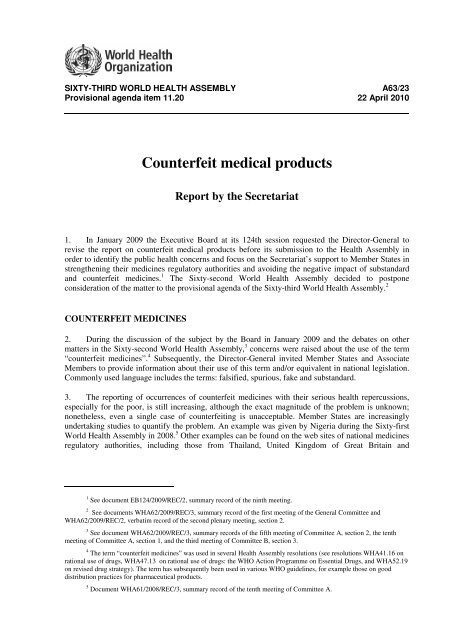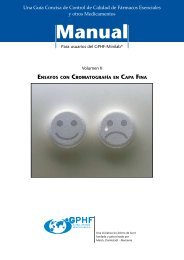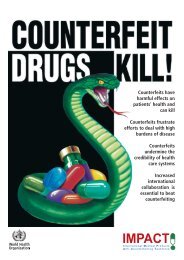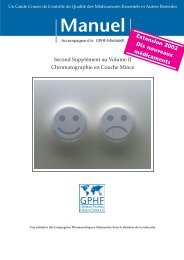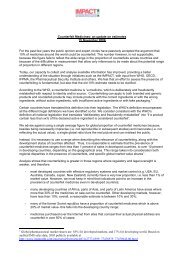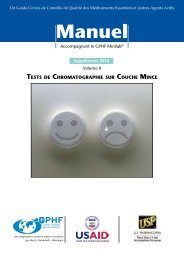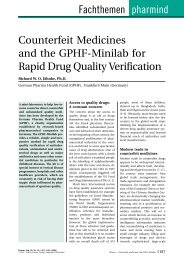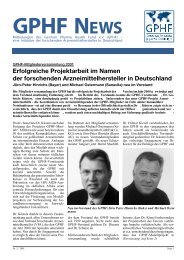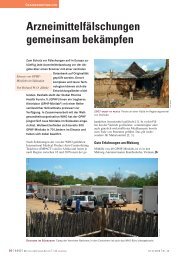Counterfeit Medical Products, Report by the Secretariat
Counterfeit Medical Products, Report by the Secretariat
Counterfeit Medical Products, Report by the Secretariat
You also want an ePaper? Increase the reach of your titles
YUMPU automatically turns print PDFs into web optimized ePapers that Google loves.
SIXTY-THIRD WORLD HEALTH ASSEMBLY A63/23<br />
Provisional agenda item 11.20 22 April 2010<br />
<strong>Counterfeit</strong> medical products<br />
<strong>Report</strong> <strong>by</strong> <strong>the</strong> <strong>Secretariat</strong><br />
1. In January 2009 <strong>the</strong> Executive Board at its 124th session requested <strong>the</strong> Director-General to<br />
revise <strong>the</strong> report on counterfeit medical products before its submission to <strong>the</strong> Health Assembly in<br />
order to identify <strong>the</strong> public health concerns and focus on <strong>the</strong> <strong>Secretariat</strong>’s support to Member States in<br />
streng<strong>the</strong>ning <strong>the</strong>ir medicines regulatory authorities and avoiding <strong>the</strong> negative impact of substandard<br />
and counterfeit medicines. 1 The Sixty-second World Health Assembly decided to postpone<br />
consideration of <strong>the</strong> matter to <strong>the</strong> provisional agenda of <strong>the</strong> Sixty-third World Health Assembly. 2<br />
COUNTERFEIT MEDICINES<br />
2. During <strong>the</strong> discussion of <strong>the</strong> subject <strong>by</strong> <strong>the</strong> Board in January 2009 and <strong>the</strong> debates on o<strong>the</strong>r<br />
matters in <strong>the</strong> Sixty-second World Health Assembly, 3 concerns were raised about <strong>the</strong> use of <strong>the</strong> term<br />
“counterfeit medicines”. 4 Subsequently, <strong>the</strong> Director-General invited Member States and Associate<br />
Members to provide information about <strong>the</strong>ir use of this term and/or equivalent in national legislation.<br />
Commonly used language includes <strong>the</strong> terms: falsified, spurious, fake and substandard.<br />
3. The reporting of occurrences of counterfeit medicines with <strong>the</strong>ir serious health repercussions,<br />
especially for <strong>the</strong> poor, is still increasing, although <strong>the</strong> exact magnitude of <strong>the</strong> problem is unknown;<br />
none<strong>the</strong>less, even a single case of counterfeiting is unacceptable. Member States are increasingly<br />
undertaking studies to quantify <strong>the</strong> problem. An example was given <strong>by</strong> Nigeria during <strong>the</strong> Sixty-first<br />
World Health Assembly in 2008. 5 O<strong>the</strong>r examples can be found on <strong>the</strong> web sites of national medicines<br />
regulatory authorities, including those from Thailand, United Kingdom of Great Britain and<br />
1 See document EB124/2009/REC/2, summary record of <strong>the</strong> ninth meeting.<br />
2 See documents WHA62/2009/REC/3, summary record of <strong>the</strong> first meeting of <strong>the</strong> General Committee and<br />
WHA62/2009/REC/2, verbatim record of <strong>the</strong> second plenary meeting, section 2.<br />
3 See document WHA62/2009/REC/3, summary records of <strong>the</strong> fifth meeting of Committee A, section 2, <strong>the</strong> tenth<br />
meeting of Committee A, section 1, and <strong>the</strong> third meeting of Committee B, section 3.<br />
4 The term “counterfeit medicines” was used in several Health Assembly resolutions (see resolutions WHA41.16 on<br />
rational use of drugs, WHA47.13 on rational use of drugs: <strong>the</strong> WHO Action Programme on Essential Drugs, and WHA52.19<br />
on revised drug strategy). The term has subsequently been used in various WHO guidelines, for example those on good<br />
distribution practices for pharmaceutical products.<br />
5 Document WHA61/2008/REC/3, summary record of <strong>the</strong> tenth meeting of Committee A.
A63/23<br />
Nor<strong>the</strong>rn Ireland, United Republic of Tanzania and United States of America. In addition, WHO has<br />
carried out studies in Myanmar and Viet Nam. 1<br />
4. The variety of information sources makes compiling statistics a difficult task. Sources include<br />
reports from national medicines regulatory authorities, enforcement agencies, pharmaceutical<br />
companies and nongovernmental organizations, as well as ad hoc studies of specific geographical<br />
areas or <strong>the</strong>rapeutic groups. The different methods used in <strong>the</strong> studies and to produce reports<br />
compound <strong>the</strong> difficulties in compiling and comparing data. Studies can give only snapshots of <strong>the</strong><br />
immediate situation. <strong>Counterfeit</strong>ers are extremely flexible in <strong>the</strong> methods <strong>the</strong>y use to mimic products<br />
and prevent <strong>the</strong>ir detection. They can rapidly change <strong>the</strong>se methods, so that <strong>the</strong> results of a study when<br />
released may already be outdated. Fur<strong>the</strong>rmore, information about a case under legal investigation is<br />
sometimes made public only after <strong>the</strong> investigation has been concluded.<br />
5. WHO also has been collecting data related to counterfeit medicines, 2 as no accurate data on <strong>the</strong><br />
extent of <strong>the</strong> problem exist and any type of product can be counterfeited. In some countries occurrence<br />
of counterfeiting relates to expensive hormones, steroids and anticancer medicines and<br />
pharmaceuticals related to lifestyle; in o<strong>the</strong>rs it may relate to inexpensive generic medicines. In<br />
developing countries <strong>the</strong> most disturbing occurrence is <strong>the</strong> common availability of counterfeit<br />
medicines for <strong>the</strong> treatment of life-threatening conditions such as malaria, tuberculosis and HIV/AIDS.<br />
Experience has shown that vulnerable patient groups who pay for medicines out of <strong>the</strong>ir own pocket<br />
are often <strong>the</strong> most affected.<br />
6. The basic investigational elements of studies aimed at identifying <strong>the</strong> magnitude of <strong>the</strong> problem<br />
of counterfeiting in a national market are sound laboratory testing and verification of information<br />
available from national medicines regulatory authorities. Despite such measures, it is hard to trace <strong>the</strong><br />
source. Close collaboration with <strong>the</strong> original manufacturers (which mostly use new technologies to<br />
identify <strong>the</strong>ir products unambiguously) and enforcement agencies (which use forensic means of<br />
analysis) has proved to be effective in tracing and fully identifying counterfeit medicines in recent years.<br />
7. Most countries have mechanisms in place for regulatory authorities to take measures against<br />
substandard medicines and <strong>the</strong>ir manufacturers, but, as counterfeiters usually work in unauthorized<br />
settings, within international networks and are not easily traceable, <strong>the</strong> above-mentioned national and<br />
regional regulatory procedures for law enforcement may be only partially successful. Thus, <strong>the</strong> normal<br />
regulatory approach for legally manufactured but substandard medicines cannot be used alone and<br />
<strong>the</strong>re is a need for national and international collaboration with o<strong>the</strong>r governmental institutions, such<br />
as legislative bodies, enforcement agencies and courts.<br />
8. <strong>Counterfeit</strong>ing is primarily motivated <strong>by</strong> its potentially huge profits and counterfeiters are adept<br />
at quickly adjusting to different contexts and products for which <strong>the</strong>y can make <strong>the</strong> most money.<br />
Factors that facilitate <strong>the</strong> production or circulation of counterfeit medical products include lack of<br />
appropriate legislation, absence or weakness of national medicines regulatory authorities, inadequate<br />
enforcement of existing legislation and weak penal sanctions.<br />
1 Document WHO/EDM/QSM/99.3.<br />
2 For details see <strong>the</strong> WHO web site under Health Topics.<br />
2
A63/23<br />
WHO’S INVOLVEMENT IN COMBATING COUNTERFEIT MEDICINES<br />
9. In response to a recommendation <strong>by</strong> <strong>the</strong> Conference of Experts on <strong>the</strong> Rational Use of Drugs<br />
(Nairobi, 25–29 November 1985), at which <strong>the</strong> problem of counterfeit medicines was first discussed at<br />
<strong>the</strong> international level, WHO with o<strong>the</strong>r international and nongovernmental organizations set up a<br />
clearinghouse to collect data and to inform governments about <strong>the</strong> nature and extent of counterfeiting.<br />
10. As requested <strong>by</strong> resolution WHA41.16 in 1988, <strong>the</strong> Director-General initiated programmes for<br />
<strong>the</strong> prevention and detection of <strong>the</strong> export, import and smuggling of falsely labelled, counterfeited or<br />
substandard pharmaceutical preparations.<br />
11. The first international meeting on counterfeit medicines, a workshop organized jointly <strong>by</strong> WHO<br />
and <strong>the</strong> International Federation of Pharmaceutical Manufacturers and Associations, was held from<br />
1 to 3 April 1992 in Geneva in response to this resolution. The participants agreed on <strong>the</strong> following<br />
definition:<br />
A counterfeit medicine is one which is deliberately and fraudulently mislabelled with respect to<br />
identity and/or source. <strong>Counterfeit</strong>ing can apply to both branded and generic products and<br />
counterfeit products may include products with <strong>the</strong> correct ingredients or with <strong>the</strong> wrong<br />
ingredients, without active ingredients, with insufficient active ingredient or with fake<br />
packaging.<br />
12. The workshop also adopted comprehensive recommendations which urged <strong>the</strong> commitment of<br />
all parties involved in medicines manufacture, distribution and use, including pharmacists and<br />
consumers, to solving <strong>the</strong> problem of counterfeit medicines.<br />
13. Given <strong>the</strong> rapid spread of counterfeit medicines in many national distribution channels, and<br />
following <strong>the</strong> adoption <strong>by</strong> <strong>the</strong> Health Assembly of resolution WHA47.13 in 1994, <strong>the</strong> <strong>Secretariat</strong> has<br />
provided support to Member States in <strong>the</strong>ir efforts to ensure that available medicines were of good<br />
quality and in combating <strong>the</strong> use of counterfeit medicines.<br />
14. In 1995, WHO, with financial assistance from <strong>the</strong> Government of Japan, launched <strong>the</strong> Project<br />
on <strong>Counterfeit</strong> Drugs. The objective was to support Member States in assessing <strong>the</strong> problem of<br />
counterfeit medicines and designing measures to combat counterfeiting. As one of <strong>the</strong> first outcomes<br />
of <strong>the</strong>se efforts, <strong>the</strong> <strong>Secretariat</strong> drafted guidelines for <strong>the</strong> development of measures to combat<br />
counterfeit medicines.<br />
15. Increasing international trade of pharmaceuticals and sales through <strong>the</strong> Internet has fur<strong>the</strong>r<br />
facilitated <strong>the</strong> entry of counterfeit products into <strong>the</strong> supply chain. In a meeting before <strong>the</strong> eleventh<br />
International Conference of Drug Regulatory Authorities (Madrid, 16–19 February 2004), combating<br />
of counterfeit medicines was reviewed. The main recommendations were taken up in <strong>the</strong> Conference<br />
and WHO was requested to develop a concept paper for an international convention on counterfeit<br />
medicines and to convene a regulators’ meeting to discuss it. The regulators’ meeting and fur<strong>the</strong>r<br />
explanatory work revealed that <strong>the</strong>re was no consensus among Member States for such an<br />
international convention; thus <strong>the</strong> idea to start a wide action-oriented international partnership led <strong>by</strong><br />
WHO emerged.<br />
16. In 2006 this led to WHO’s launch of <strong>the</strong> International <strong>Medical</strong> <strong>Products</strong> Anti-<strong>Counterfeit</strong>ing<br />
Taskforce, which has become <strong>the</strong> main conduit for WHO’s work on counterfeit medicines. Following<br />
discussions at <strong>the</strong> Sixty-first World Health Assembly and <strong>the</strong> 124th session of <strong>the</strong> Executive Board,<br />
3
A63/23<br />
<strong>the</strong> <strong>Secretariat</strong> has established a programme to coordinate its work to combat counterfeit medicines,<br />
including coordination with <strong>the</strong> members of <strong>the</strong> Taskforce and providing it with secretariat functions.<br />
17. In order to assist Member States in <strong>the</strong>ir discussion on this topic WHO’s new anti-counterfeiting<br />
programme aims to distinguish clearly between <strong>the</strong> WHO <strong>Secretariat</strong>’s activities and those of <strong>the</strong><br />
Taskforce. Two different web sites 1 have been established. A new WHO fact sheet has been issued. 2<br />
Major efforts have been undertaken to mobilize resources for <strong>the</strong> new programme.<br />
18. After reports had been received about <strong>the</strong> increased occurrence of counterfeit medicines during<br />
<strong>the</strong> pandemic of influenza A (H1N1) 2009, WHO issued an alert to warn about <strong>the</strong> purchase of<br />
antiviral agents without a prescription, including purchase over <strong>the</strong> Internet. 3<br />
19. In response to <strong>the</strong> Director-General’s request (paragraph 2) for information on use of <strong>the</strong> term<br />
“counterfeit medicines” and related definitions, 55 Member States and <strong>the</strong> European Commission have<br />
so far provided answers, and a preliminary summary was presented to <strong>the</strong> Member States at an open<br />
forum held in Geneva on 26 March 2010. An analysis and subsequent inputs will be presented to <strong>the</strong><br />
Expert Committee on Specifications for Pharmaceutical Preparations for fur<strong>the</strong>r discussion. The<br />
Expert Committee’s recommendations will be set forth in its report and <strong>the</strong> Director-General will<br />
submit a report on its meeting to <strong>the</strong> Executive Board in line with <strong>the</strong> Regulations for Expert Advisory<br />
Panels and Committees. 4<br />
20. In October 2009 <strong>the</strong> Expert Committee on Specifications for Pharmaceutical Preparations at its<br />
forty-fourth meeting recommended <strong>the</strong> revision of <strong>the</strong> WHO guidelines on good distribution practices<br />
for pharmaceutical products, building on <strong>the</strong> input from <strong>the</strong> Taskforce’s working group on regulatory<br />
implementation. 5<br />
QUALITY<br />
21. The tools and systems for quality assurance of medicines developed under <strong>the</strong> auspices of<br />
WHO’s Expert Committee on Specifications for Pharmaceutical Preparations help many public health<br />
actors to work towards ensuring that all essential medicines, including those used in treating large<br />
populations, are safe, effective and of good quality. The norms, standards and guidelines reviewed <strong>by</strong><br />
<strong>the</strong> Committee are prepared through a rigorous consultative process involving WHO’s Member States,<br />
national authorities and international agencies such as UNICEF. They are submitted to WHO’s<br />
governing bodies for information and subsequent implementation <strong>by</strong> Member States.<br />
22. The comprehensive guidelines for quality assurance include recommendations that cover <strong>the</strong><br />
development and production of medicines through to <strong>the</strong>ir distribution to patients. 6 Development of<br />
quality assurance standards is usually triggered <strong>by</strong> resolutions adopted <strong>by</strong> <strong>the</strong> Health Assembly and<br />
1 http://www.who.int/medicines/services/counterfeit/en/index.html and http://www.who.int/impact/en/index.html.<br />
2 http://www.who.int/mediacentre/factsheets/fs275/en/index.html.<br />
3 http://www.who.int/medicines/publications/drugalerts/Alert_122_Antivirals.pdf.<br />
4 Basic documents, 47th edition. World Health Organization, Geneva, 2009.<br />
5 See document EB127/10.<br />
6 The guidelines can be found on <strong>the</strong> WHO web site under Health Topics.<br />
4
A63/23<br />
Executive Board and <strong>by</strong> <strong>the</strong> biennial International Conference of Drug Regulatory Authorities. These<br />
international guidelines have also contributed to <strong>the</strong> improvement of medicines regulation at country<br />
and global levels. Besides setting norms and standards, WHO supports countries in building national<br />
regulatory capacity. These activities have also been endorsed and supported <strong>by</strong> <strong>the</strong> Health Assembly<br />
through numerous resolutions.<br />
23. The core functions of WHO’s medicines regulatory support programmes include <strong>the</strong> provision<br />
of direct country and regional support for streng<strong>the</strong>ning medicines regulation; developing and<br />
continuously improving tools to assist regulatory work; facilitating communication; and promoting<br />
harmonization among medicines regulatory authorities.<br />
24. Country support involves assessing medicines regulatory systems to identify needs, prepare<br />
institutional plans, and provide financial support and capacity building, based on WHO’s data<br />
collection tools and methodology. To date, 44 assessments have been made of 40 regulatory systems<br />
with <strong>the</strong> involvement of regional offices and in close collaboration with <strong>the</strong> capacity-building teams<br />
from <strong>the</strong> WHO <strong>Secretariat</strong>. Technical assistance has also been given to regional harmonization<br />
initiatives and for supporting <strong>the</strong> participation of bodies such as <strong>the</strong> Sou<strong>the</strong>rn African Development<br />
Community, East African Community and <strong>the</strong> Caribbean Community.<br />
25. WHO has organized <strong>the</strong> International Conference of Drug Regulatory Authorities every two<br />
years since 1980 with <strong>the</strong> objective of promoting harmonization, exchange of information, and finding<br />
collaborative approaches to problems of common concern to medicines and biological regulatory<br />
authorities worldwide.<br />
26. In addition, <strong>the</strong> Prequalification of Medicines Programme forms part of WHO’s activities in this<br />
area. This service aims to facilitate access to medicines that meet unified international standards of<br />
quality, safety and efficacy for HIV/AIDS, malaria, tuberculosis and reproductive health. Established<br />
in 2001, it was originally intended to promote consistency across United Nations procurement systems<br />
such as those of UNICEF and UNAIDS, and to present <strong>the</strong>m with a choice of high-quality medicines.<br />
The Programme draws on <strong>the</strong> expertise of some of <strong>the</strong> leading national regulatory authorities to<br />
provide a list of prequalified products that comply with unified international standards. 1<br />
REGIONAL ACTIVITIES ON COUNTERFEIT MEDICINES<br />
27. Weak medicines regulatory authorities and proliferation of illicit medicines in many countries of<br />
<strong>the</strong> African Region are major challenges. An interregional meeting on combating counterfeit medical<br />
products (Abuja, 29 and 30 October 2008) was attended <strong>by</strong> medicines regulatory authorities, police<br />
and <strong>the</strong> customs authorities of 13 countries in <strong>the</strong> Region. It was proposed that WHO should continue<br />
to support countries to develop initiatives focused on <strong>the</strong> specific needs and problems related to<br />
counterfeit medical products; undertake country studies to quantify <strong>the</strong> magnitude of <strong>the</strong> problem; and<br />
draw up information, education and communication strategies on <strong>the</strong> dangers of counterfeit medical<br />
products for health workers and <strong>the</strong> general public. At a two-day regional conference on combating<br />
counterfeit medical products (Johannesburg, South Africa, 9 and 10 November 2009), organized <strong>by</strong><br />
1 WHO gratefully acknowledges <strong>the</strong> assistance provided in 2008 <strong>by</strong> staff from <strong>the</strong> medicines regulatory authorities of<br />
Australia, Austria, Brazil, Canada, China, Estonia, Ethiopia, France, Germany, Ghana, Hungary, Italy, Kenya, <strong>the</strong><br />
Ne<strong>the</strong>rlands, Poland, Singapore, South Africa, Spain, Sweden, Switzerland, Uganda, Ukraine, United Kingdom of Great<br />
Britain and Nor<strong>the</strong>rn Ireland, United Republic of Tanzania and Zimbabwe.<br />
5
A63/23<br />
<strong>the</strong> International Criminal Police Organization and WHO under <strong>the</strong> auspices of <strong>the</strong> International<br />
<strong>Medical</strong> <strong>Products</strong> Anti-<strong>Counterfeit</strong>ing Taskforce, representatives from <strong>the</strong> invited 15 national<br />
medicines regulatory authorities, police and customs reviewed <strong>the</strong> situation regarding counterfeit<br />
medicines across sou<strong>the</strong>rn Africa, particularly within members of <strong>the</strong> Sou<strong>the</strong>rn African Development<br />
Community. The meeting concluded with several recommendations for enhancing cooperation<br />
between <strong>the</strong> various agencies involved. Participants agreed to establish a proper legal framework to<br />
support prosecutions, <strong>the</strong> creation of national multi-agency taskforces with links to <strong>the</strong> Taskforce, and<br />
<strong>the</strong> expansion of combined enforcement activities.<br />
28. African medicine regulators met in Maputo, Mozambique (23–26 November 2009) to discuss<br />
ways of improving <strong>the</strong> availability of essential medicines that meet safety, efficacy and quality<br />
standards. The regulators also discussed strategic approaches to streng<strong>the</strong>ning WHO’s Harmonization<br />
of Medicines Regulation in Africa project. This Second African Medicines Regulators Conference was<br />
organized to streng<strong>the</strong>n national capacities for effective medicine regulation, including prevention of<br />
circulation of counterfeit and substandard medicines in this Region.<br />
29. Within <strong>the</strong> Pan American Network for Drug Regulatory Harmonization, <strong>the</strong> Working Group on<br />
Combating Drug <strong>Counterfeit</strong> was set up in 1999. A regional study was conducted to determine <strong>the</strong><br />
situation of medicines counterfeiting in <strong>the</strong> countries of <strong>the</strong> Region of <strong>the</strong> Americas. It revealed that<br />
drug counterfeiting was a problem that existed in varying degrees in most countries of <strong>the</strong> Region. To<br />
bring greater focus to <strong>the</strong> problem, <strong>the</strong> Working Group created a road map for use in evaluating <strong>the</strong><br />
cycle of implementation <strong>by</strong> each country’s focal point and to implement prevention and combating of<br />
medicines counterfeiting as part of <strong>the</strong>ir national health authorities. In late 2008, <strong>the</strong> Regional Office<br />
for <strong>the</strong> Americas issued a document on <strong>the</strong> situation on Prevention and Combat of <strong>Counterfeit</strong><br />
Medicines in <strong>the</strong> Caribbean Countries. The Working Group on Combating Drug <strong>Counterfeit</strong> of <strong>the</strong> Pan<br />
American Network for Drug Regulatory Harmonization organized three national meetings for<br />
supporting <strong>the</strong> establishment of national anti-counterfeiting task forces. These meetings were attended<br />
<strong>by</strong> <strong>the</strong> different parties concerned (customs authorities, police, legislative and enforcement authorities,<br />
universities, consumers associations and health ministries) and aimed at building national groups with<br />
<strong>the</strong> participation of <strong>the</strong> aforementioned stakeholders and to design a brief working plan. The meetings<br />
were held in Panama (2008), Plurinational State of Bolivia (2009) and Jamaica (2009). The first direct<br />
consequence has been in Panama where an interagency agreement to combat counterfeit medical<br />
products has been set in place.<br />
30. The Eastern Mediterranean Region Office supports Member States in <strong>the</strong> Region <strong>by</strong><br />
streng<strong>the</strong>ning national medicines regulatory authorities; building <strong>the</strong> capacity of national quality<br />
control laboratories; encouraging medicines regulatory authorities to participate in meetings and <strong>the</strong><br />
work of <strong>the</strong> International <strong>Medical</strong> <strong>Products</strong> Anti-<strong>Counterfeit</strong>ing Taskforce; and <strong>by</strong> sharing<br />
recommendations and outcomes of <strong>the</strong> Taskforce’s meetings with medicines regulatory authorities. In<br />
addition, a review of different national situations concerning counterfeit medicines has been completed<br />
and a detailed assessment is planned for at least two countries in <strong>the</strong> period 2010–2011.<br />
31. In <strong>the</strong> European Region, <strong>the</strong> Regional Office works toge<strong>the</strong>r with <strong>the</strong> regulatory authorities of<br />
Member States on combating counterfeit medicines, and provides support especially to <strong>the</strong> countries<br />
of south-eastern Europe and <strong>the</strong> newly independent states, including Armenia, Azerbaijan, Belarus,<br />
Kazakhstan, Kyrgyzstan, Republic of Moldova, Russian Federation, Ukraine and Uzbekistan. In<br />
addition, <strong>the</strong> Regional Office is closely following <strong>the</strong> efforts undertaken <strong>by</strong> <strong>the</strong> Council of Europe in<br />
<strong>the</strong> preparation of an international convention to combat counterfeiting. This convention is currently<br />
under discussion in <strong>the</strong> Council’s Committee of Ministers and is expected to be agreed later this year.<br />
The convention would specifically enlarge <strong>the</strong> legal possibilities for combating counterfeiting crimes.<br />
At <strong>the</strong> same time <strong>the</strong> European Commission and <strong>the</strong> European Union’s Member States are also<br />
6
A63/23<br />
discussing new legislation on counterfeit medicines, which is also expected to be passed in <strong>the</strong> next<br />
months.<br />
32. In <strong>the</strong> South-East Asia Region combating counterfeit medicines/medical products was<br />
discussed <strong>by</strong> <strong>the</strong> Regional Committee in 2008. 1 Member States reiterated <strong>the</strong> importance of a public<br />
health focus in combating counterfeit medicines, emphasizing quality, safety and efficacy and<br />
separating this from intellectual property rights issues. Concern was expressed at <strong>the</strong> seizure in transit<br />
of consignments of generic medicines meant for developing countries. In order to promote cooperation<br />
and streng<strong>the</strong>n regional and international collaboration on <strong>the</strong>se issues, a staff member from <strong>the</strong><br />
Regional Office participated in <strong>the</strong> African regional conference on combating counterfeiting medical<br />
products (see paragraph 28).<br />
33. Combating counterfeit medicines is a high priority in <strong>the</strong> Western Pacific Region. Technical<br />
support for both intercountry activities and individual country-specific activities has been provided<br />
over <strong>the</strong> past 10 years. These activities have included, among o<strong>the</strong>rs, intercountry workshops on<br />
combating counterfeit medicines (Cambodia, 2001; Thailand, 2002; Viet Nam, 2003; Philippines, 2005);<br />
national training on improving inspection capacity (Lao People’s Democratic Republic, Philippines,<br />
Viet Nam); intensified surveys (Cambodia, Lao People’s Democratic Republic, Mongolia, Philippines);<br />
and public advocacy activities (Cambodia, Mongolia, Philippines). A regional rapid alert system was<br />
introduced in 2004 as an early warning mechanism, involving focal points from countries and partners<br />
in <strong>the</strong> Western Pacific and South-East Asia regions. WHO has collaborated with <strong>the</strong> International<br />
Criminal Police Organization and o<strong>the</strong>r partners to investigate <strong>the</strong> distribution of fake artesunate in <strong>the</strong><br />
Greater Mekong subregion in Operation Jupiter (2006), followed <strong>by</strong> <strong>the</strong> region-wide Operation<br />
Storm (2008) and Operation Storm II (2009) to undertake criminal investigation and legal enforcement. An<br />
expert consultation was undertaken in Manila (February 2010) in order to streng<strong>the</strong>n <strong>the</strong> surveillance<br />
and alert system for combating counterfeit medicines.<br />
ACTION BY THE HEALTH ASSEMBLY<br />
34. The Health Assembly is invited to note this report.<br />
= = =<br />
1 See document SEA/RC61/27 and <strong>Report</strong> of <strong>the</strong> sixty-first session, Part 3, paragraphs 176–182.<br />
7


